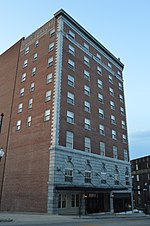Downtown Danville Historic District

The Downtown Danville Historic District is a national historic district located at Danville, Virginia. The district includes 48 contributing buildings in the central business district of Danville. It includes a wide range of commercial, industrial, and institutional building types dating from the 1870s to the present. The district includes notable examples of the Late Gothic Revival, Tudor Revival, and Romanesque Revival styles. Notable buildings include the Danville City Auditorium (1932), Morotock Manufacturing Company (1907), J. T. Stovall Tobacco Factory (1876), Kingoff Building (1892), American National Bank & Trust Co (c. 1934), Woolworth's Building (1937), Southern Amusement Building (1922), Elks Home (1912), Danville Post Office (1932), Masonic Building (1921-1922), and Danville City Market (1930s). Located in the district are the separately listed Hotel Danville and the Danville Municipal Building.It was listed on the National Register of Historic Places in 1993. Downtown Danville Historic District Contributing Buildings
Excerpt from the Wikipedia article Downtown Danville Historic District (License: CC BY-SA 3.0, Authors, Images).Downtown Danville Historic District
Main Street, Danville
Geographical coordinates (GPS) Address Nearby Places Show on map
Geographical coordinates (GPS)
| Latitude | Longitude |
|---|---|
| N 36.587222222222 ° | E -79.393888888889 ° |
Address
Main Street
Main Street
24541 Danville
Virginia, United States
Open on Google Maps










